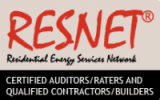Conducting a home energy audit is the best way to learn about how your house can run in a more energy-efficient manner. Ultimately, this will save you money. There are many benefits to having a home energy audit. For example, you can learn more about the best insulation techniques and air sealing a house during an energy audit. This information is valuable for knowing how to make the changes that are necessary for optimum energy efficiency.
Sealing leaks
A home energy audit will inform you of all the air leaks that are present in the house. Finding and eliminating air leaks, such as leaks coming from exterior walls, is important because it helps you save both energy and money. Sealing leaks is an integral step in making your home as energy-efficient as possible. An energy audit will make you aware of how to seal some of the most common gaps that are found in your home.
Insulate around recessed lighting
Recessed lights often have vents that open in the attic that provide a route for air to escape. Often, there are several recessed lights throughout a house. When air leaks through all the spaces, it becomes problematic. Insulating these areas prevents the air from escaping, saving both energy and money.
Plug open stud cavities
You may have to do some investigating in the attic to check your studs, but the effort is worth it. If the cavities are open, here are our DIY tips. Seal them with fiberglass insulation that is stuffed into a plastic garbage bag. If you have large gaps, cover them with some drywall or reflective foil insulation.
Close gaps around flues and chimneys
Flues and chimneys are famous for allowing air to flow through. Nip it in the bud by covering the gaps with aluminum flashing that you seal into place with silicone caulk. Wrap a cylinder of flashing around the flue to keep the insulation a safe distance from the hot flue.
Weatherstrip the attic access door
A gap that measures a mere ¼” around the attic door allows an excessive amount of air to escape. Caulking between the stair frame and rough opening will seal the gap. You can also install foam weatherstripping around the perimeter of the opening.
Squirt foam in medium-sized gaps
Plug-up medium-sized gaps with low-expansion polyurethane foam. This material is ideal for closing gaps that measure ¼” to 3”. Openings of this size are usually found in areas around plumbing pipes and vents.
Caulk skinny gaps
Gaps that are less than ¼” wide are best combated with caulk. These gaps are usually found around electric boxes and similar areas. The price of caulk can vary depending on the material from which it is made, and each type (silicone and acrylic) has its own benefits. Silicone is a bit more expensive but works well in small areas. Acrylic is less expensive, is easy to work with and easy to clean.
Plug gaps in the basement
Gaps above the outside soil level can be problematic in basements, as they can let intemperate air into the house. Outdoor air entering the house can be as costly to a homeowner as indoor air seeping out can be. It is imperative that these gaps are covered as soon as they are identified. Use caulk for gaps that are less than ¼” wide, spray foam for wider ones, and high-temperature caulk for areas that are prone to be affected by heat, such as near the furnace or water heater. Wide holes should be plugged up with foam.
Tighten up around windows and doors
Windows and doors account for most of the drafts in a home. If your windows are old, try caulking around them or adding weatherstripping.
The importance of insulation
Having a home energy audit will also teach you about the importance of insulating your house. Insulating is equally important to saving energy as sealing leaks are. Some details a home energy audit will teach you about insulating include the following:
-
Use loose-fill or batt insulation to fill the attic.
-
Seal and insulate any ducts that are not unconditioned.
-
Insulate a cathedral ceiling properly to keep indoor temperatures consistent.
-
Use blow-in insulation on your exterior walls that already exist. If you are remodeling and your walls are open, use two-part spray foam or wet spray cellulose insulation.
-
A properly insulated foundation keeps below-grade rooms more comfortable.
-
A properly insulated basement will save you money on heating the home.
-
Insulate a cold concrete slab so it is easier to heat.
Learning about air sealing a house and insulating your home can provide a great deal of helpful information that will help you save energy and money. Schedule your home energy audit today and get ready to learn everything you need to know about air sealing and insulating your home. And once you’ve done our audit, if you don’t want to do the reapirs yourself, there are many contractors in the area that can give yuo a cost estimate and help you in no time.
Thank you for reading our blog! How can we help you? Contact us today.



